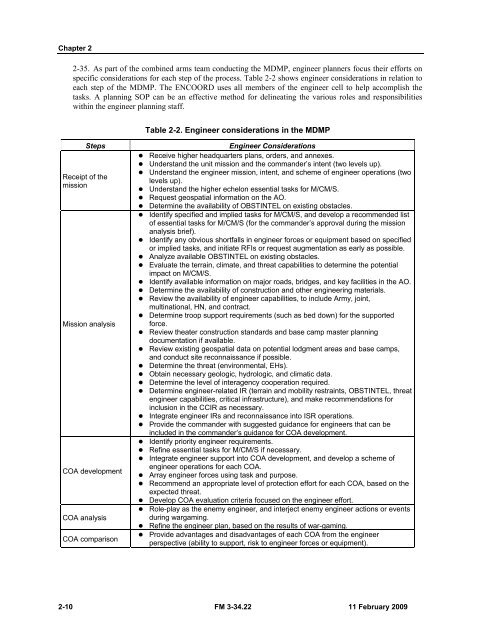FM 3-34.22 - Army Electronic Publications & Forms - U.S. Army
FM 3-34.22 - Army Electronic Publications & Forms - U.S. Army
FM 3-34.22 - Army Electronic Publications & Forms - U.S. Army
You also want an ePaper? Increase the reach of your titles
YUMPU automatically turns print PDFs into web optimized ePapers that Google loves.
Chapter 2<br />
2-35. As part of the combined arms team conducting the MDMP, engineer planners focus their efforts on<br />
specific considerations for each step of the process. Table 2-2 shows engineer considerations in relation to<br />
each step of the MDMP. The ENCOORD uses all members of the engineer cell to help accomplish the<br />
tasks. A planning SOP can be an effective method for delineating the various roles and responsibilities<br />
within the engineer planning staff.<br />
Receipt of the<br />
mission<br />
Table 2-2. Engineer considerations in the MDMP<br />
Steps Engineer Considerations<br />
Mission analysis<br />
COA development<br />
COA analysis<br />
COA comparison<br />
� Receive higher headquarters plans, orders, and annexes.<br />
� Understand the unit mission and the commander’s intent (two levels up).<br />
� Understand the engineer mission, intent, and scheme of engineer operations (two<br />
levels up).<br />
� Understand the higher echelon essential tasks for M/CM/S.<br />
� Request geospatial information on the AO.<br />
� Determine the availability of OBSTINTEL on existing obstacles.<br />
� Identify specified and implied tasks for M/CM/S, and develop a recommended list<br />
of essential tasks for M/CM/S (for the commander’s approval during the mission<br />
analysis brief).<br />
� Identify any obvious shortfalls in engineer forces or equipment based on specified<br />
or implied tasks, and initiate RFIs or request augmentation as early as possible.<br />
� Analyze available OBSTINTEL on existing obstacles.<br />
� Evaluate the terrain, climate, and threat capabilities to determine the potential<br />
impact on M/CM/S.<br />
� Identify available information on major roads, bridges, and key facilities in the AO.<br />
� Determine the availability of construction and other engineering materials.<br />
� Review the availability of engineer capabilities, to include <strong>Army</strong>, joint,<br />
multinational, HN, and contract.<br />
� Determine troop support requirements (such as bed down) for the supported<br />
force.<br />
� Review theater construction standards and base camp master planning<br />
documentation if available.<br />
� Review existing geospatial data on potential lodgment areas and base camps,<br />
and conduct site reconnaissance if possible.<br />
� Determine the threat (environmental, EHs).<br />
� Obtain necessary geologic, hydrologic, and climatic data.<br />
� Determine the level of interagency cooperation required.<br />
� Determine engineer-related IR (terrain and mobility restraints, OBSTINTEL, threat<br />
engineer capabilities, critical infrastructure), and make recommendations for<br />
inclusion in the CCIR as necessary.<br />
� Integrate engineer IRs and reconnaissance into ISR operations.<br />
� Provide the commander with suggested guidance for engineers that can be<br />
included in the commander’s guidance for COA development.<br />
� Identify priority engineer requirements.<br />
� Refine essential tasks for M/CM/S if necessary.<br />
� Integrate engineer support into COA development, and develop a scheme of<br />
engineer operations for each COA.<br />
� Array engineer forces using task and purpose.<br />
� Recommend an appropriate level of protection effort for each COA, based on the<br />
expected threat.<br />
� Develop COA evaluation criteria focused on the engineer effort.<br />
� Role-play as the enemy engineer, and interject enemy engineer actions or events<br />
during wargaming.<br />
� Refine the engineer plan, based on the results of war-gaming.<br />
� Provide advantages and disadvantages of each COA from the engineer<br />
perspective (ability to support, risk to engineer forces or equipment).<br />
2-10 <strong>FM</strong> 3-<strong>34.22</strong> 11 February 2009

















